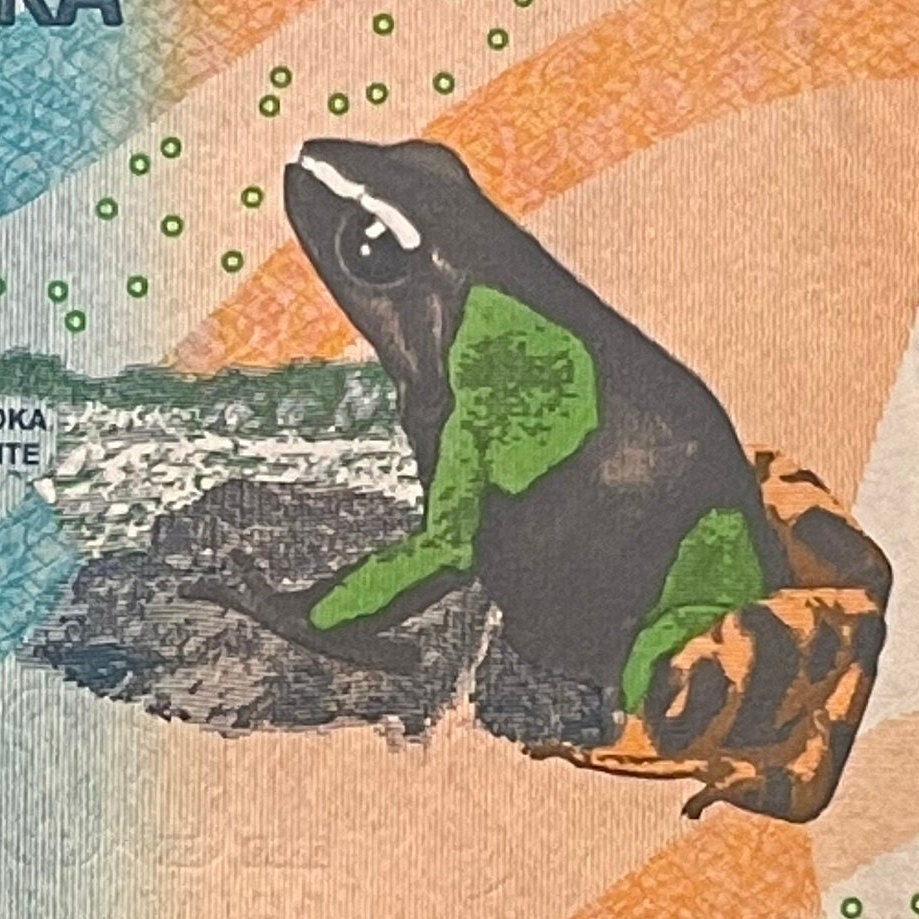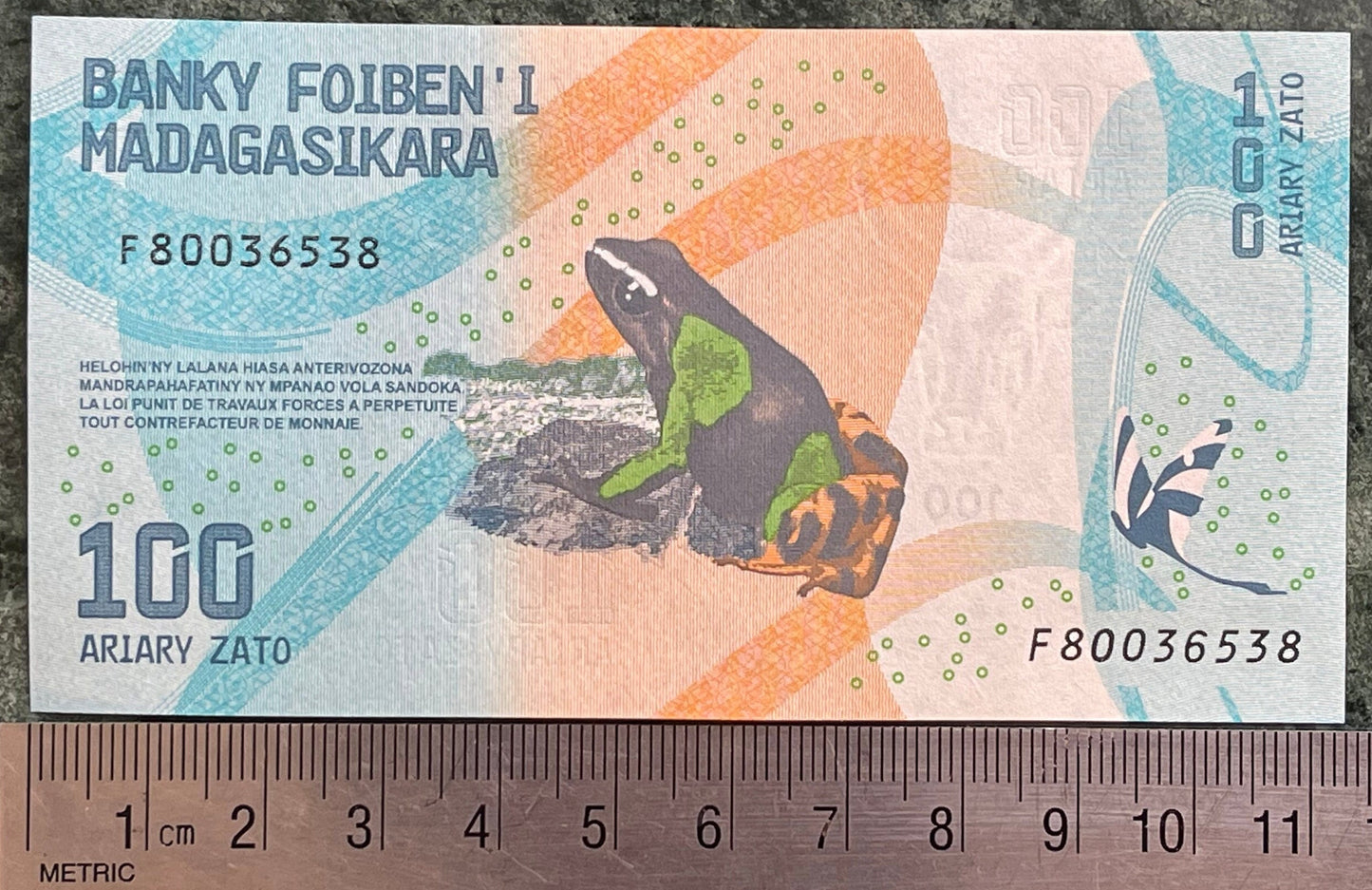elemintalshop
Madagascar Poison Frog & Ambozontany Cathedral 100 Ariary Authentic Banknote Money for Jewelry and Collage (2017) (Zebu) (Fianarantsoa)
Madagascar Poison Frog & Ambozontany Cathedral 100 Ariary Authentic Banknote Money for Jewelry and Collage (2017) (Zebu) (Fianarantsoa)
Couldn't load pickup availability
Madagascar Poison Frog & Ambozontany Cathedral 100 Ariary Authentic Banknote Money for Jewelry and Collage (2017) (Fianarantsoa)
Reverse: Madagascar Poison Frog (Mantella baroni). Waterfall. Volute. Comet moth a.k.a. Madagascan moon moth (Argema mittrei)
Obverse: Ambozontany Cathedral and the view of Fianarantsoa. Butterfly. Map outline of Madagascar. Birds in flight.
Lettering: BANKY FOIBEN'I MADAGASIKARA
ARIARY ZATO
Water Mark: Head of a Zebu (Bos taurus indicus); Electrotype "100".
UV turtle on front.
Features
Issuer Madagascar
Period Fourth Republic (2010-date)
Type Standard banknote
Year 2017
Value 100 Ar - Malagasy ariary
100 MGA = USD 0.025
Currency Ariary (1961-date)
Composition Paper
Size 114 × 60 mm
Shape Rectangular
Number N# 202898
References P# 97
Wikipedia:
Mantella baroni (often known by its common names, such as Baron's mantella, the variegated golden frog, or the Madagascar poison frog) is a species of small poisonous frog in the family Mantellidae.
The species was first formally described by George Albert Boulenger in 1888, who penned the species' binomial after Richard Baron, an English botanist and missionary to Madagascar, who collected and studied the species.
Most individuals in this species display specific unique characteristics that distinguish them from other Mantella species, such as a "light rostral line above the eyes" and "tiger-like markings on the hind limbs" of "orange with irregular black stripes". However, a wide variety of phenotypes exist, which manifest in front limb colors ranging from light greens to vibrant oranges and yellows, and are sometimes mistaken or imported into the international marketplace as Mantella cowanii.
Moreover, the "front limbs and femurs are yellow to greenish in appearance, with this coloration continuing up the flanks into a large, rounded flank blotch", which mirrors the commonplace appearance of the species Mantella madagascariensis, known as the painted mantella. These blotches "contrast with the black dorsum and striking orange and black legs" in both species, making it difficult for distributors, vendors, herpetologists, breeders, collectors, and pet owners to acquire the correct species. The easiest way to differentiate the two species is to note the "sky-blue, horseshoe-shaped marking" present on the throat of the painted mantella, as well as the lack of "flashmarks on the lower hindlimbs" on the Baron's mantella. Due to their similar appearance, the Baron's mantella is sometimes informally called a "painted mantella" as well, despite the painted mantella being a distinct species altogether.
Diet, predation, and toxicology
Mantella baroni is a very active forager and can consume a greater number of prey (consisting of large arthropods) than any other Mantella species, consisting of large arthropods. While most frog species are nocturnal, the Mantella baroni is a diurnal hunter. Its diet consists mainly of ants, while also consuming a number of other types of arthropods like beetles, spiders, and mites.
Ingesting mites allows them to secrete high pharmacologically-active alkaloid concentrations in their skin, making them toxic to predators, with their bright colors serving as a warning sign that ingestion could be dangerous and induce sickness. The intensity of this alkaloid concentration can flux both temporally and geographically, but careless human handling is always discouraged. Human activity may influence the level of Mantella toxicity by polluting the environment, killing its sources of food and limiting an otherwise diversified diet, so remote populations may be more potent.
******
The imposing Ambozontany Cathedral, built at 1890, dominates the slyline of Fianarantosa. Walk through the Haute Ville to discover narrow streets with European-Style houses next to new typical Malagasy buildings. But above all the atmosphere of the streets on Sunday with people well dressed up, to go to Mass o simpli celebrate holiday.
Source: https://www.tripadvisor.com/Attraction_Review-g298271-d8685149-Reviews-Cattedrale_Di_Ambozontany-Fianarantsoa_Fianarantsoa_Province.html
Wikipedia:
The Holy Name of Jesus Cathedral (French: Cathédrale du Saint-Nom de Jésus Malagasy: Katedraly ny Anarana Masin'i Jesoa) is a religious building that serves as a cathedral of the Roman Catholic Church and is located in the town of Fianarantsoa, in the highlands of African and island country of Madagascar. It is located specifically in the Rue du Rova (Rova Street), in the old town, and is the seat of the Archdiocese of Fianarantsoa (Latin: Archidioecesis Fianarantsoaensis).
Share










Very pretty! Much smaller than I was expecting but it's still a very nice note!
I have a friend who has studied poisonous frogs. She's going to love this. Colors are better than the photo.
I am so happy to add this to my collection. It's perfect!









